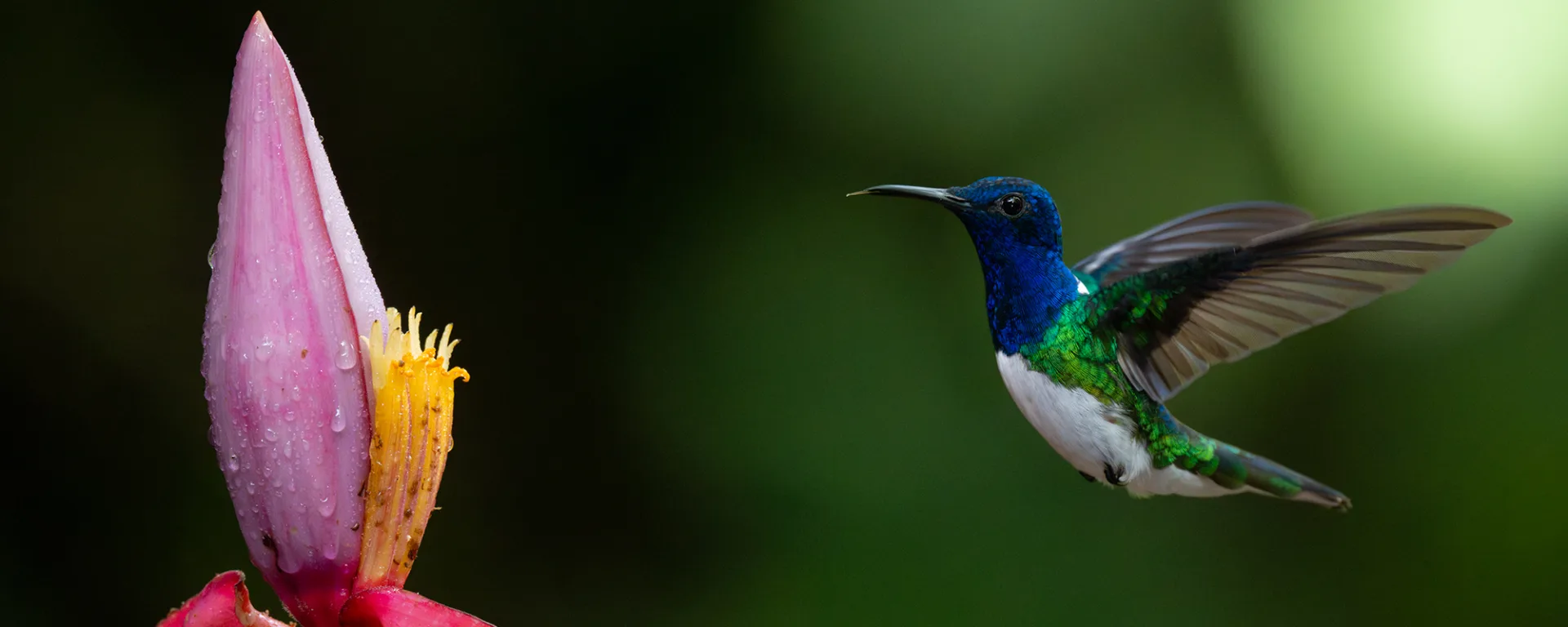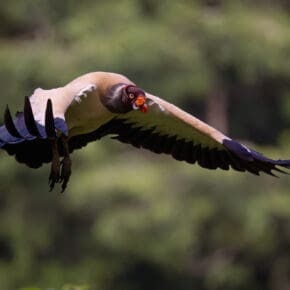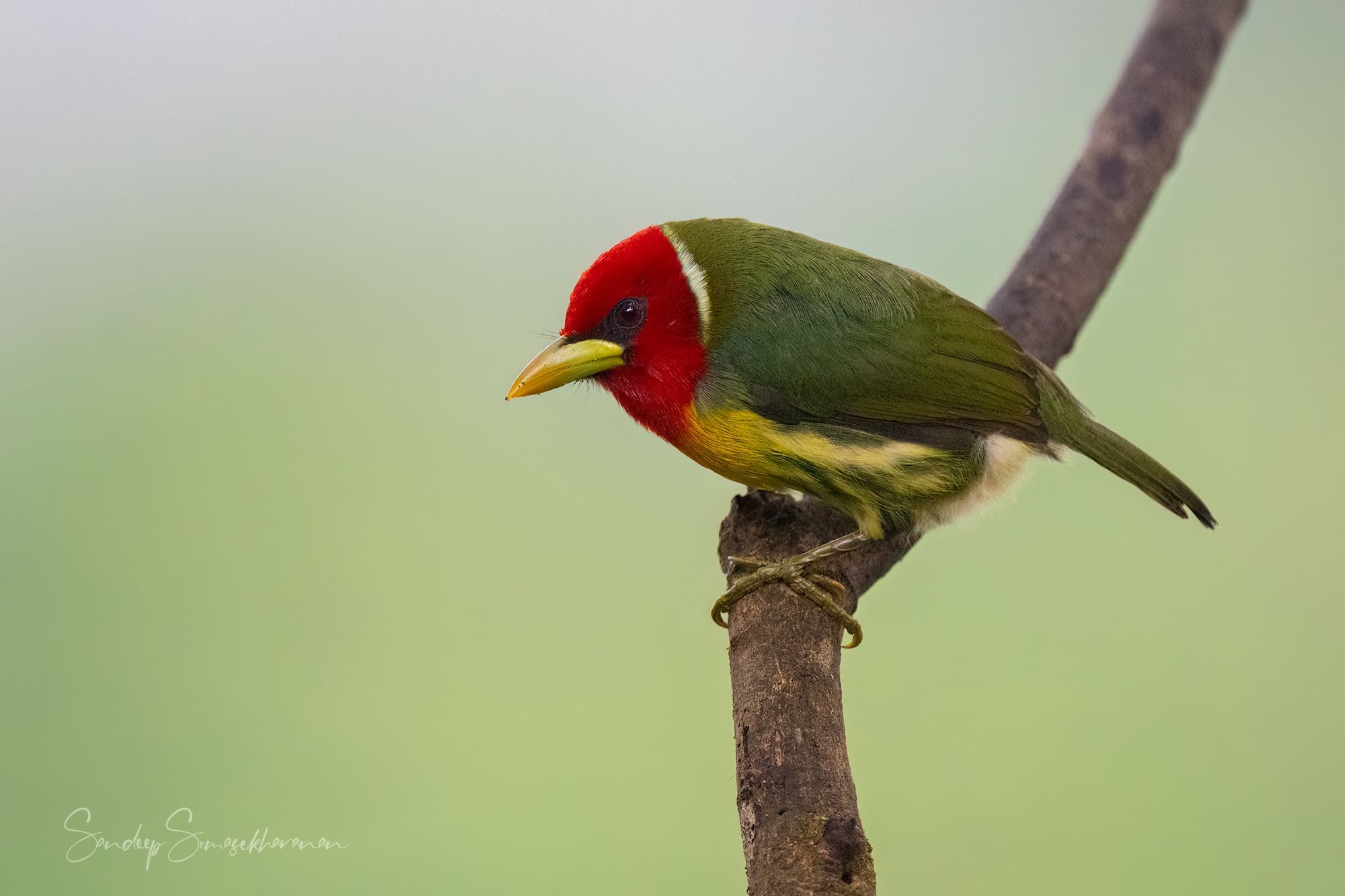In the first part of this series, we visited Cinchona and Sarapiqui. We dined at a restaurant that also served birds — as patrons! And we met a few striking barbets that we presumed were partners but turned out to be unrelated. And that was just Day 1 in Costa Rica. In part 2, we head to Guapiles to spend just another day in paradise.
On Day 2, we are to have an early start. My biological clock disregards the one-hour difference in time zones from North Carolina, and wakes me earlier. After a refreshing morning shower (a welcome change from shivering-showering on winter mornings in the US), I wander the grounds at La Quinta.

Hidden in pla(i)ntain sight
It is a beautiful morning with clear skies and a mild breeze. A resort employee is hauling an enormous bunch of plantains past the pool. Based on the previous evening’s experience, I gather that there has to be a feeder nearby.
Beside the pool is a clearing beyond which a river flows. In its midst stands a wooden platform, blackened the decomposing plantain droppings. The plantain bunch is now suspended there and the moment the employee steps away, the birds arrive.
First in is a primal-looking bird, slightly smaller than a wild turkey, which walks dexterously on the wire, like a tightrope-walker, towards the feeder. This is the Grey-Headed Chachalaca (Ortalis cinereiceps). Shortly afterward, a new guest appears, with a long black body and a luxuriant tail, which prompts the larger bird to beat a retreat. This is the Costa Rican Weasel, Tayra (Eira barbara). It appears to have recently endured some sort of misadventure, as it sports fresh gashes on its face. The Tayra too clambers up towards the feeder and begins devouring the bananas. The smaller birds, which do not appear to mind the mammalian presence, swarm the feeders.
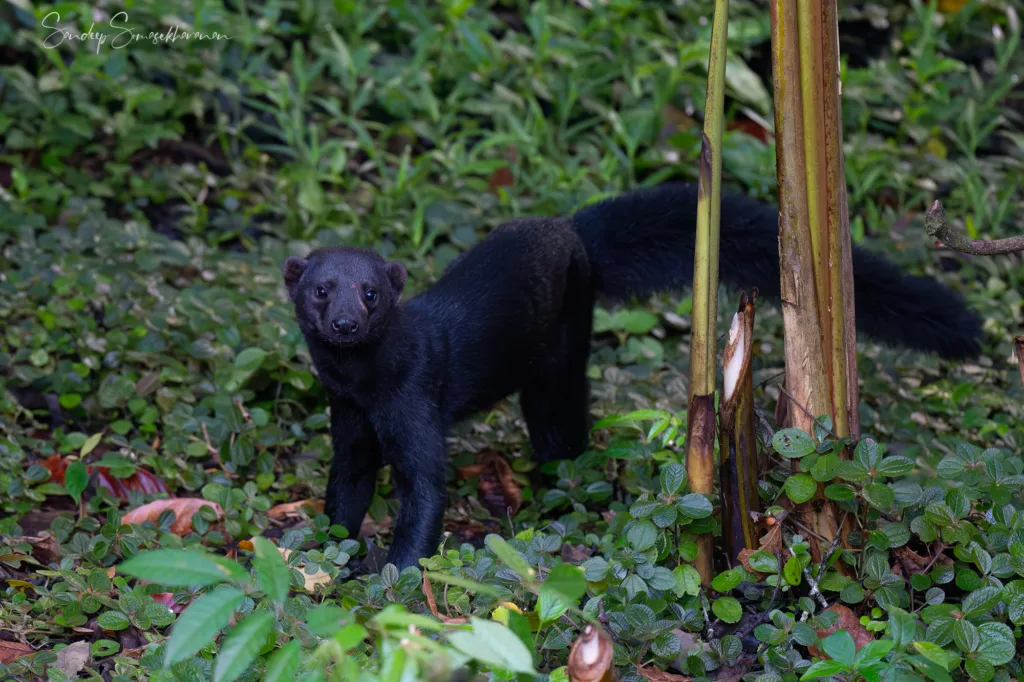

The stunning blue Red-legged Honeycreepers (Cyanerpes cyaneus) are tanagers but resemble the sunbirds of Asia and Africa, both in their aspect as in their vibrant colors. A pair of Collared Aracaris (Pteroglossus torquatus) appear, though they do not come down to the feeder and remain on the trees. There is also a bird that resembles a kingbird, which we later identify as a Social Flycatcher (Myiozetetes similis) (bearing a close resemblance to a Great Kiskadee Pitangus sulphuratus that we also saw in the area), which hunts for insects attracted to the rotting fruit strewn around the feeder. A Rufous-tailed Hummingbird (Amazilia tzacatl) flits around the flowers.
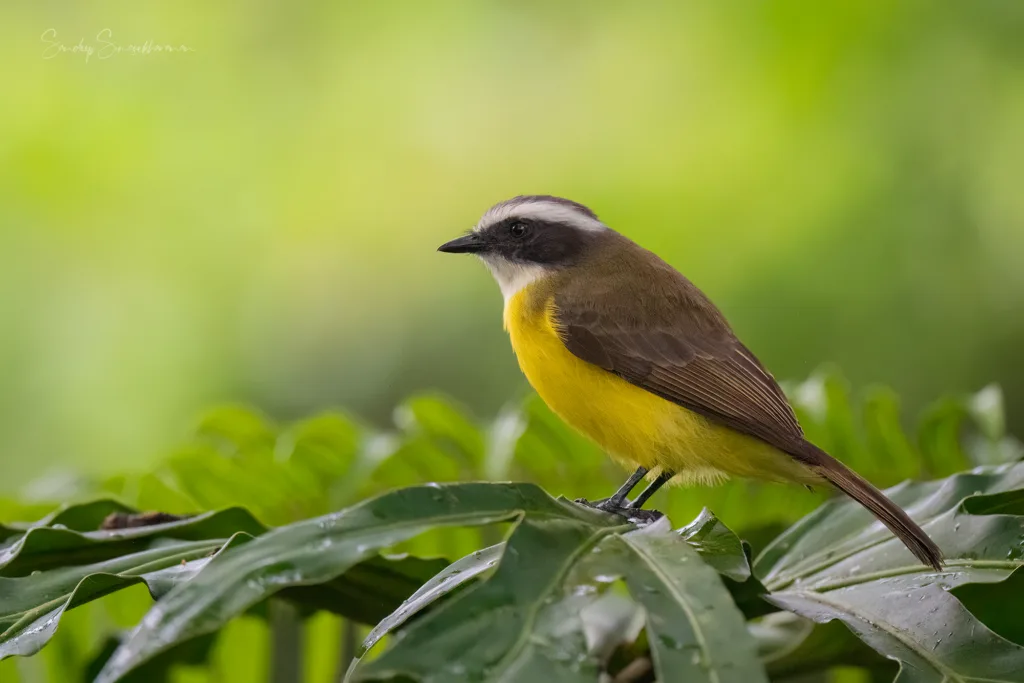
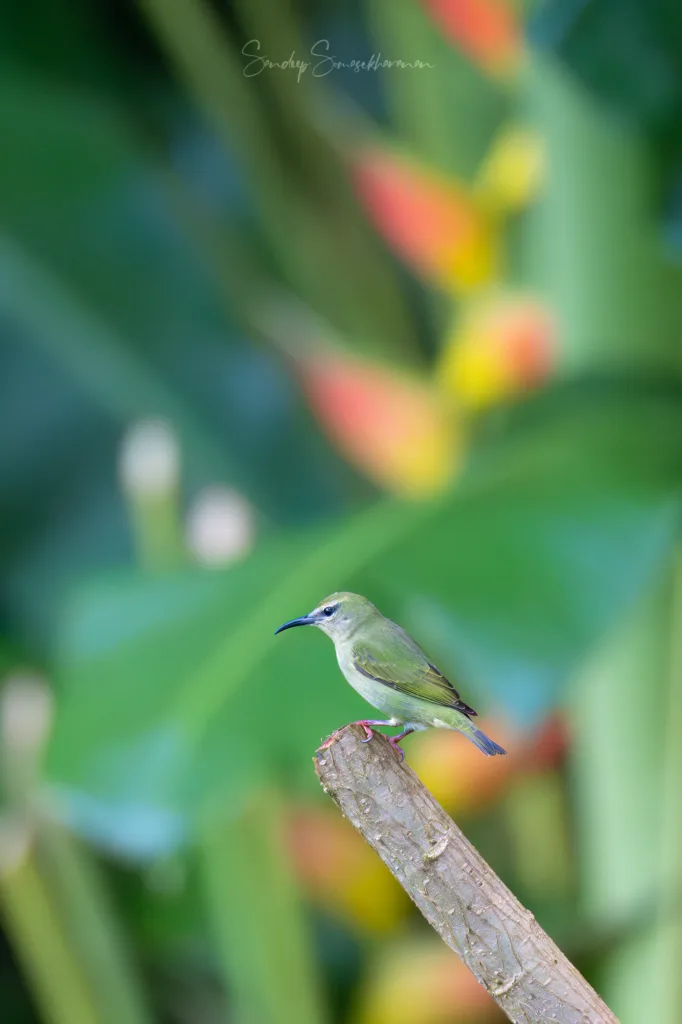
Heading to Guapiles
Over breakfast, Orlando teaches everyone to say “Buenos Dias!” (the first word is pronounced ‘Buenas’). After filling up on fruit, toast, and eggs, along with cereal, we pile into Orlando’s silver Toyota van and begin our hour-long ride to Guapiles.
The plan for the day reads: “Birding at a private residence, forest walk to spot and photograph owls”. Outside the window, the landscape is as lush as in Kerala after fresh monsoon showers. There is much in common between this part of the world and home: the houses are made of concrete with flat terraced roofs mounted with dish antennae. Almost all the windows and doors are fortified with thick metal grilles, a hint that even though Costa Rica is safe for tourists, petty crime is a threat.
We pull up on an unpaved track in front of a densely planted property, and walk through a tunnel of trees to see the house. Clothes are drying outside a shed. Orlando introduces us to a short, wiry man. As a disclaimer, Jose Alberto Perez aka Cope (Ko-pay), says, “My English not very good.”
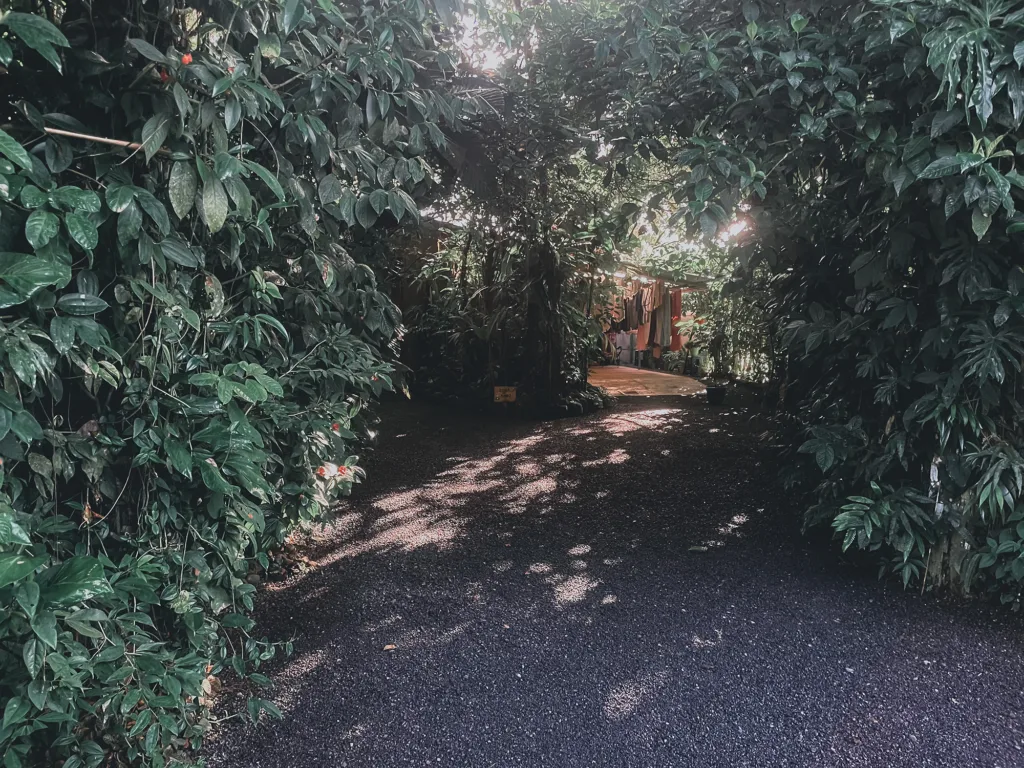
Cope’s backyard – the pride of Guapiles
He leads us to the back of his house, and once again we are nearly assaulted by hummingbirds zipping back and forth between the nectar feeders. Cope brings us to a tiny observation shack overlooking a creek. Knee-length rubber boots are lined up at the back of the shack along with a few plastic stools for visitors to sit on.
All over the backyard are brilliantly colored White-necked Jacobins (Florisuga mellivora), whose name baffles us till Murukesh locates a tiny white stripe on the back of the neck, in one of the pictures. There are also Rufous-tailed Hummingbirds, which we understand are one of the most common hummingbirds in Costa Rica. The White-necked Jacobins put out a bold display, unfurling their white, skirt-like tails when aggravated by the presence of another hummingbird.

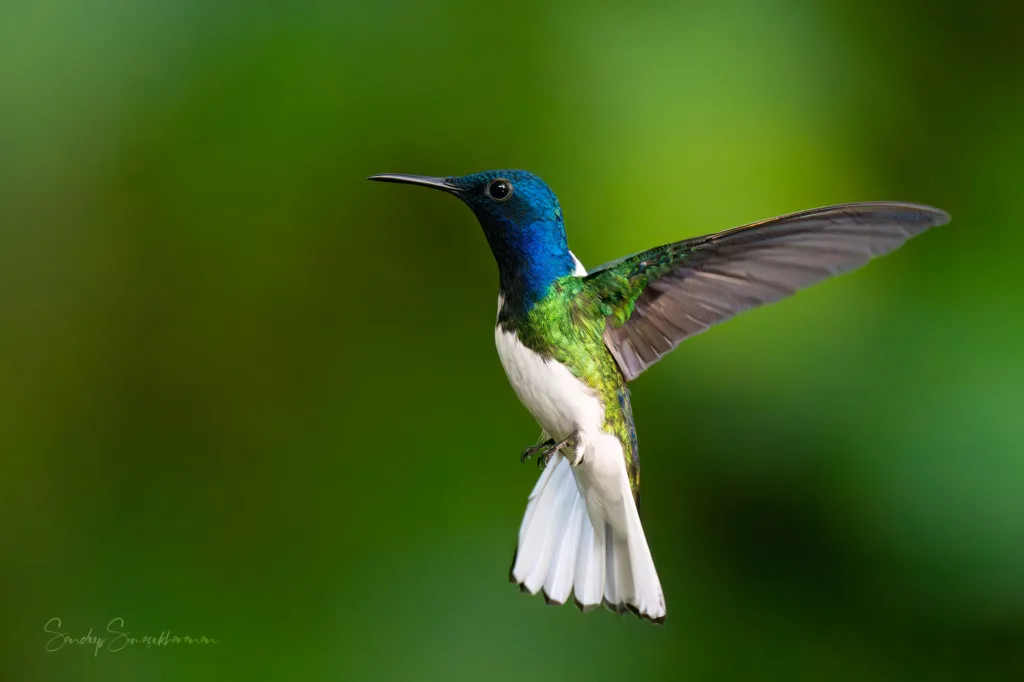
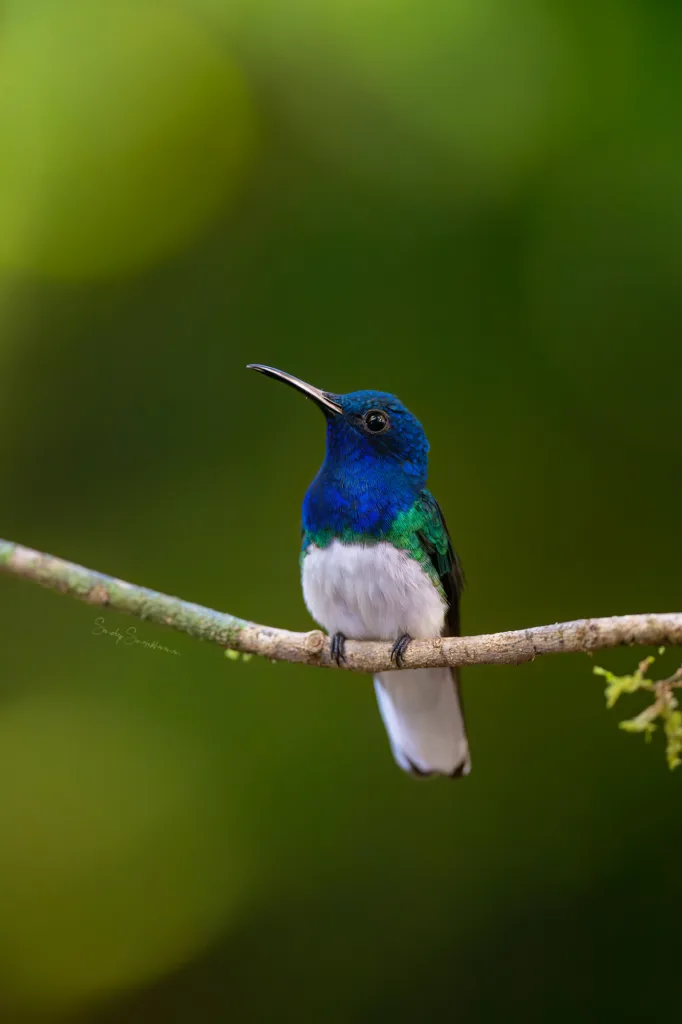

A few yards of gravelly bank separate us from the feeder platform erected on the river bed. Nails are hammered in all over the feeder, on which are hung plantains and papayas – no surprises there. A cacophony of parakeet calls suddenly transports me back to evenings in Mysuru, as a bunch of Orange-chinned Parakeets (Brotogeris jugularis) descend on the feeder. These birds wear an expression of being perpetually amused. The other birds back away as the parakeets frolic around the plantains.
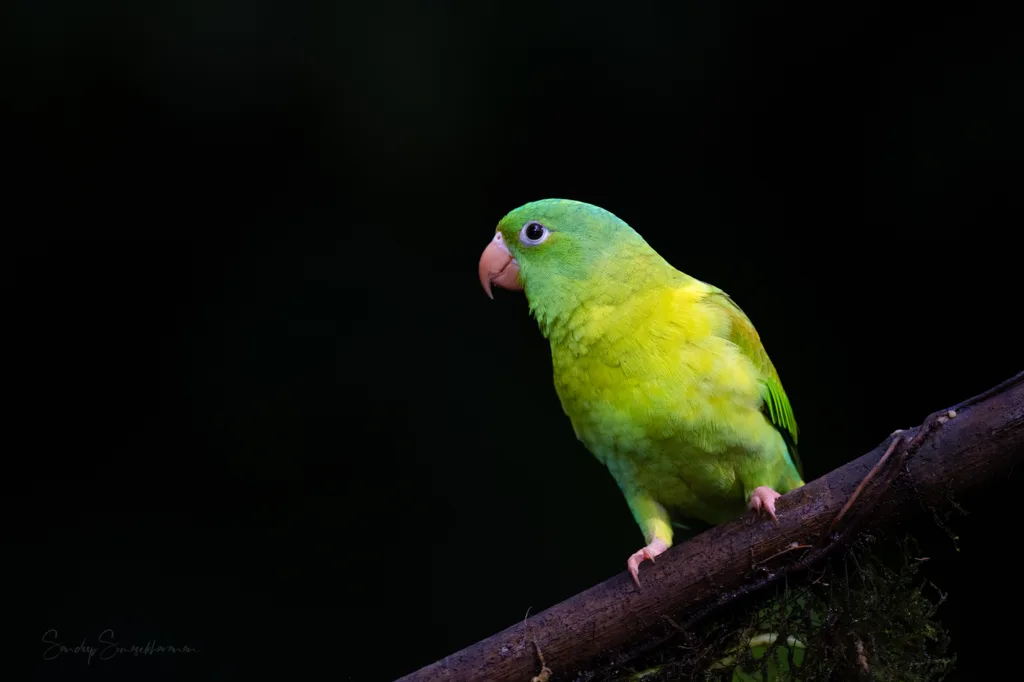
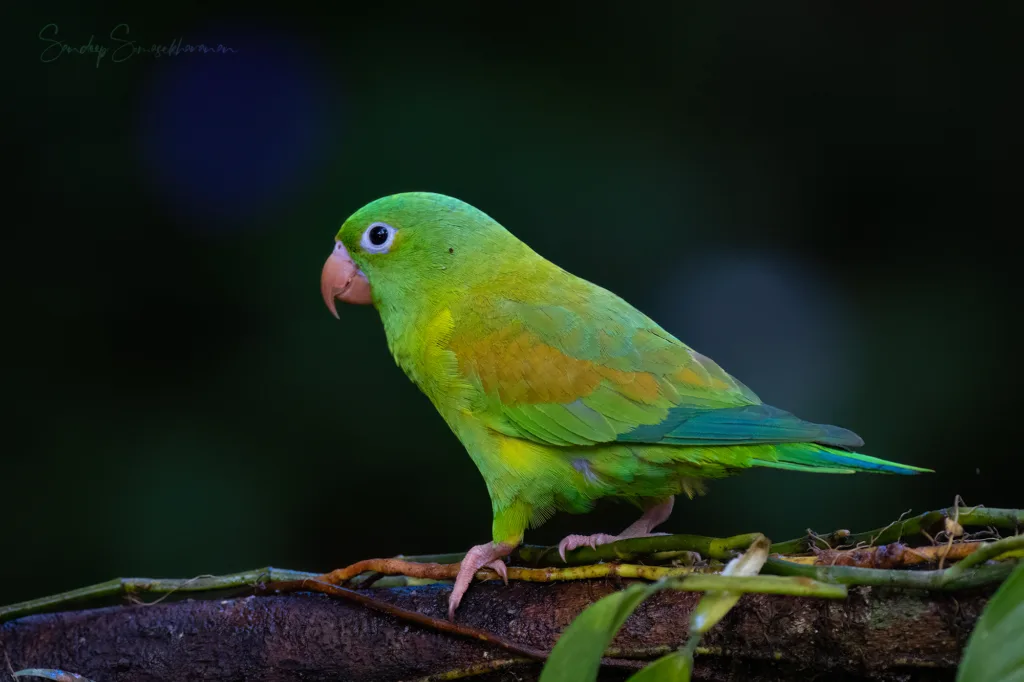
All of a sudden, the place resounds with a loud, metallic, bubbling call, almost straight out of a science fiction movie. An enormous bird with chestnut feathers, a colorful beak, red face wattles, and yellow and black tailfeathers descends on the feeder and vigorously assaults the plantains.
“Montezuma Oropendola,” says Cope. Psarocolius montezuma is from the blackbird family, though it is hard to see why. It is named after an Aztec emperor, which though is not too hard to see why: it looks regal and majestic. The bird is too close to fit in my frame and it is soon joined by a slightly smaller bird with a chestnut head and a beak that is almost like a casque.
“Chestnut-headed Oropendola (Psarocolius wagleri).” Cope is now rattling off names at a pace that makes my head spin.
Too hot to handle!
The honeycreepers are also here, and we notice that the Red-legged Honeycreepers have yellow feathers in the underwings, making them even more eye-catching in flight. The females of the honeycreepers are way less colorful, as with much of the tanager family, sporting dull green plumage.
A woodpecker, which looks a lot like the North American Red-bellied Woodpecker, descends on the feeder. Cope points it out as a Hoffman’s Woodpecker (Melanerpes hoffmannii). I press the shutter release to capture the frenetic bird activity at such a furious pace that my camera flashes a warning about an overheating memory card – something I have never experienced in 20 years of digital photography.
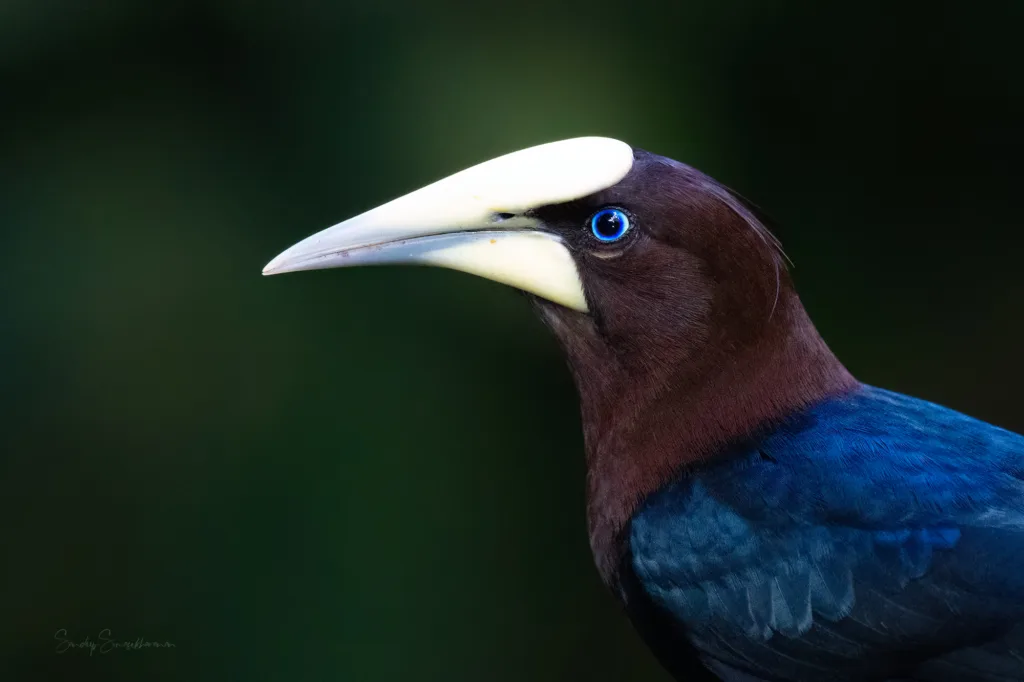

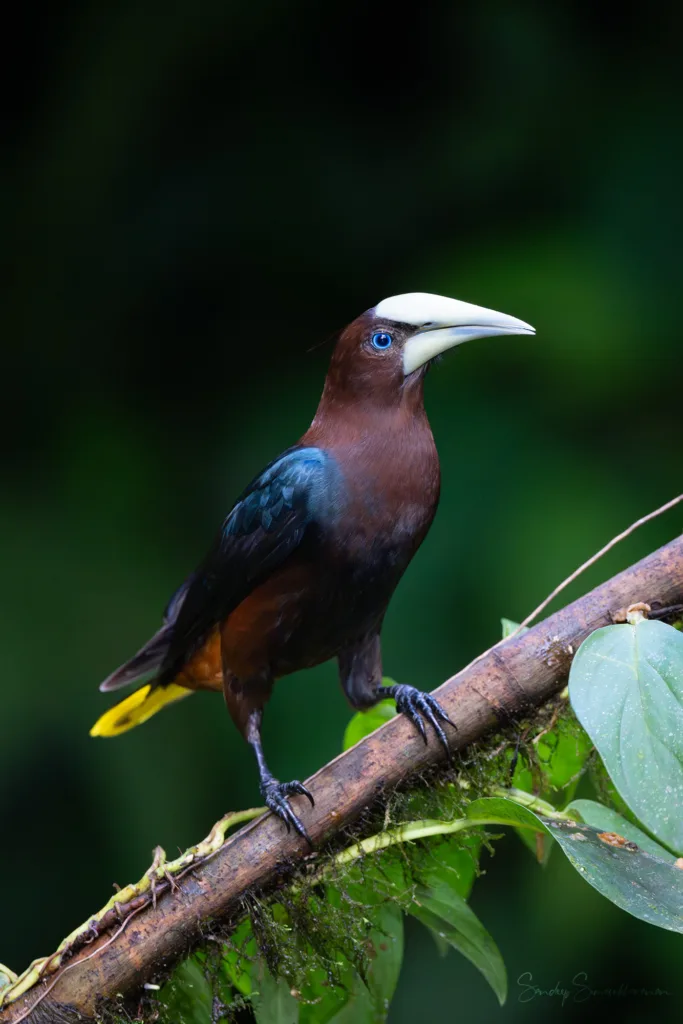

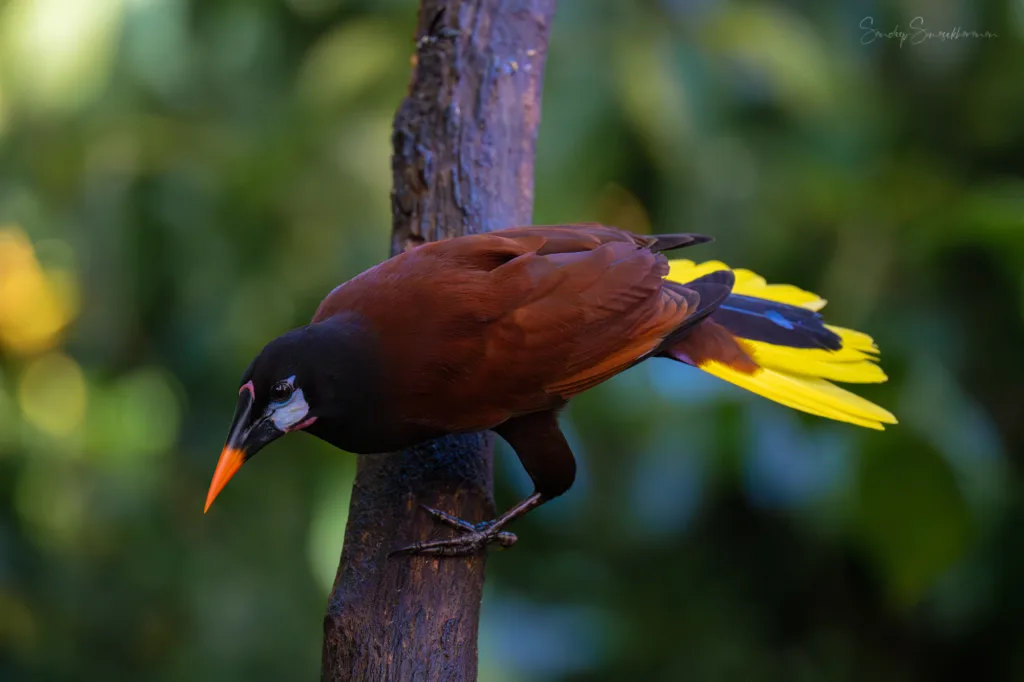
There’s a relatively plain-looking hummingbird with a beautiful fanned tail that appears at the feeder, and Cope tells us that it is a Band-tailed Barbthroat (Threnetes ruckeri). Another brown hummingbird with a splendid long tail shows up, which Cope excitedly points out as a Long-billed Hermit (Phaethornis longirostris). He shows us photos of one that had to be rescued after it was trapped inside his room that morning. “Is crazy,” says Cope. We soon realize that is his go-to expression for anything overwhelming or unusual.


Around noon, Cope suggests that we go to the forest and look for owls. He points towards the boots and asks us to pick a pair each of our size, as we would be wading through marshes.
“Oh no, not again!” I think.
Howling and owling in muddy boots
I had gone kayaking a year ago with a friend when the kayak hit the bottom of the lake and could not be rowed. We had decided to get out and wade through the shallows but got sucked down thigh-deep in the mud. The feeling of mud constricting my thighs, and my not being able to wiggle free, has since been a recurring nightmare.
With a sense of foreboding, I pull up the tallest pair of boots and get into Orlando’s car. Cope too appears, armed with a machete sheathed in a pretty scabbard. Following his direction, we douse ourselves with copious doses of bug spray all over our exposed skin. Orlando pulls up near a creek and Cope guides us into a dense rainforest.
Here, the trees are taller and it is quite impossible to spot a bird, even though we can frequently hear bird calls. We constantly hear a whistling call, which Cope tells us belongs to the Cinnamon Woodpecker (Celeus loricatus), but we do not get to see it. In the leaf litter, Cope points to a frog, hilariously called the Blue-jeans Poison Dart Frog (Oophaga pumilio), as its upper body is colored strawberry red, while the rear limbs are denim-blue. A few steps into the forest, the ground is soggy and soon encroaches into my PTSD zone by turning marshy. We wade through shin-deep water, and I steady myself holding on to a plant when lifting a foot from the muck gets tough. Cope intervenes, saying “Itching plant!” and I let go of it like it were a hot potato.
All of a sudden we hear a roar, something reminiscent of the T-rex attack scene in Jurassic Park. Cope once again comes to the rescue before I start conjecturing: “Howler monkey. Loud sound! Is crazy!”
These calls can be heard a good three miles away. The slush underfoot meanwhile starts getting trickier. It starts sucking at the rubber boots and my feet threaten to wiggle loose from the boot. After a few more minutes of wading through the nightmarish muck, we get closer to the river. Cope points into the canopy and says “Crested Owl (Lophostrix cristata)”. It takes us a few seconds to discern the well-camouflaged birds that have chosen a well-hidden perch from anyone but Cope. The pair sits there, eyes popping comically, and share a few tender moments, including a beak-to-beak kiss.
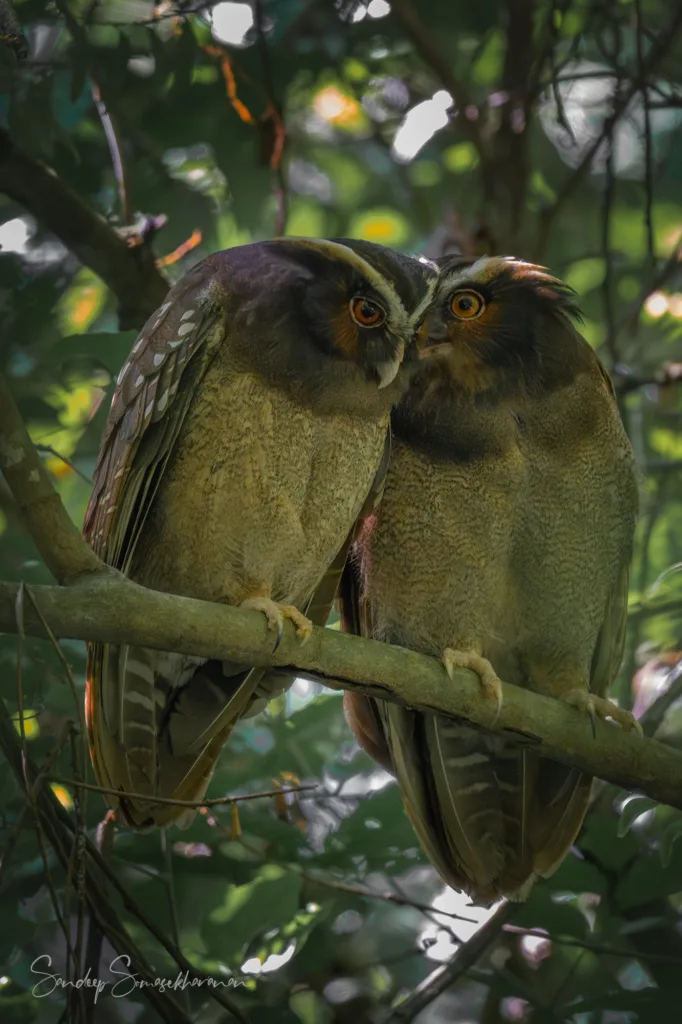
After getting our pictures (which were not great considering the terrible light) we follow Cope further into the woods. At one point, he makes us wait in the forest near a tiny stream, and walks away, clearing his way with dexterous swings of his machete. Mosquitoes assault us now, with the bug spray having dissolved away in the sweat that has now started pouring.
We get a second coat of bug spray and try to use the flowing water in the stream to clean the boots without much luck. The mud is too thick. Cope comes back beaming, having found a pair of Spectacled Owls (Pulsatrix perspicillata) in a beautiful spot, and asks us to be very quiet as these owls are extremely shy. He brings us to a point from where we have a clear view of a magnificent owl with white markings around both eyes. Its mate is hidden from sight on an adjacent branch. We stand there quietly and fire away for fifteen minutes, never troubling the owls even a bit.
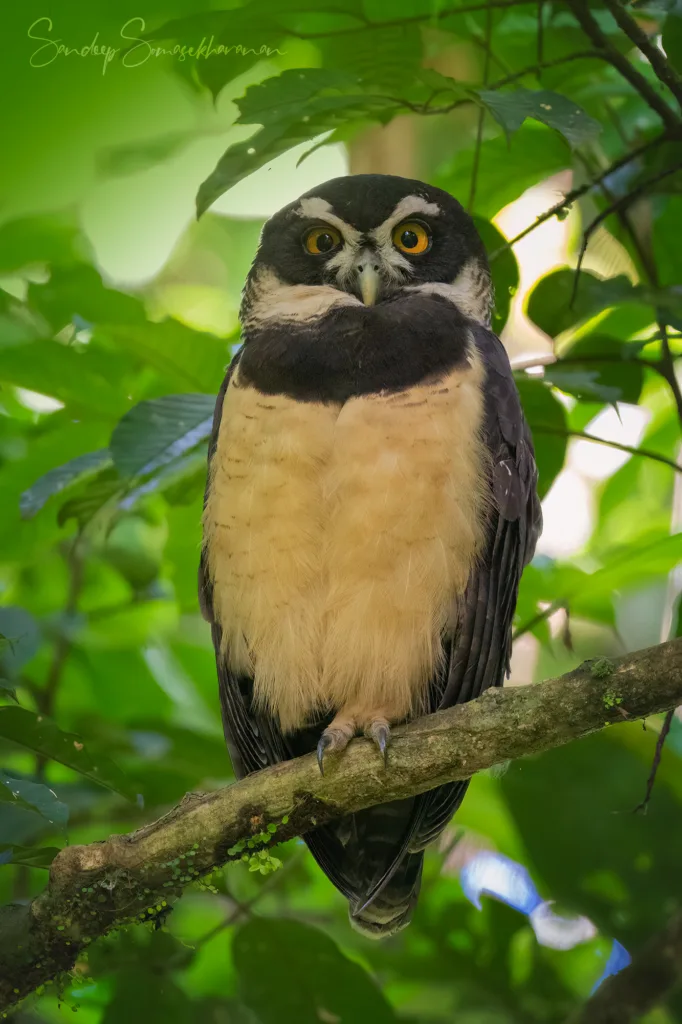
In the mood for dumplings
Cope brings us back to the trail and towards a wild banana sapling. This stands five and a half feet tall and has all but five leaves. One of those leaves is conspicuously folded in the center like a tent and he asks us to look inside from under. We are pleasantly surprised to see tiny white dumplings clinging to the spine of the leaf, packing the inside. These are the Honduran White Bats (Ectophylla alba), which are nothing short of celebrities in Costa Rica. The bats fashion these tents out of the otherwise flat banana leaves by biting their ribs out, making them collapse inwards. Cope educates us that they are reliant on a single species of fig for sustenance.
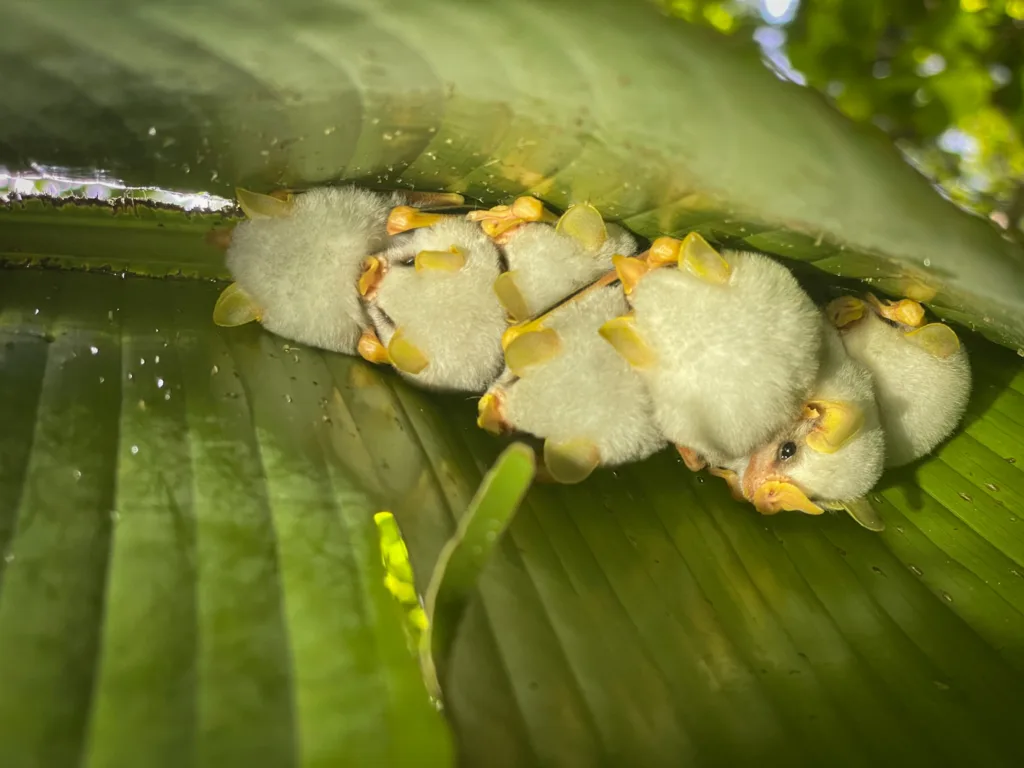

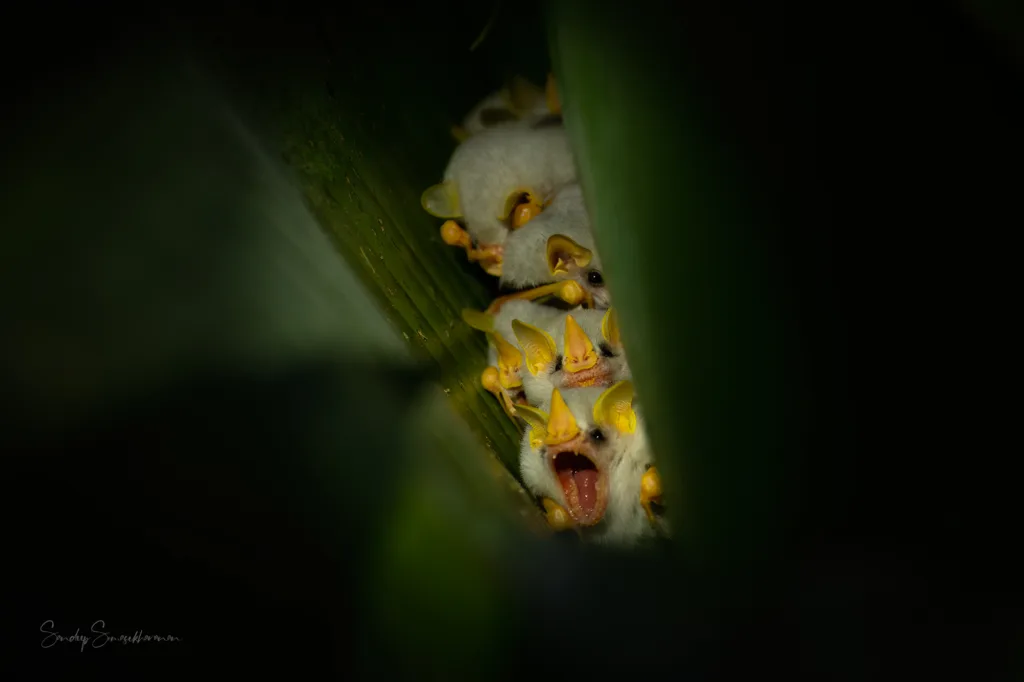
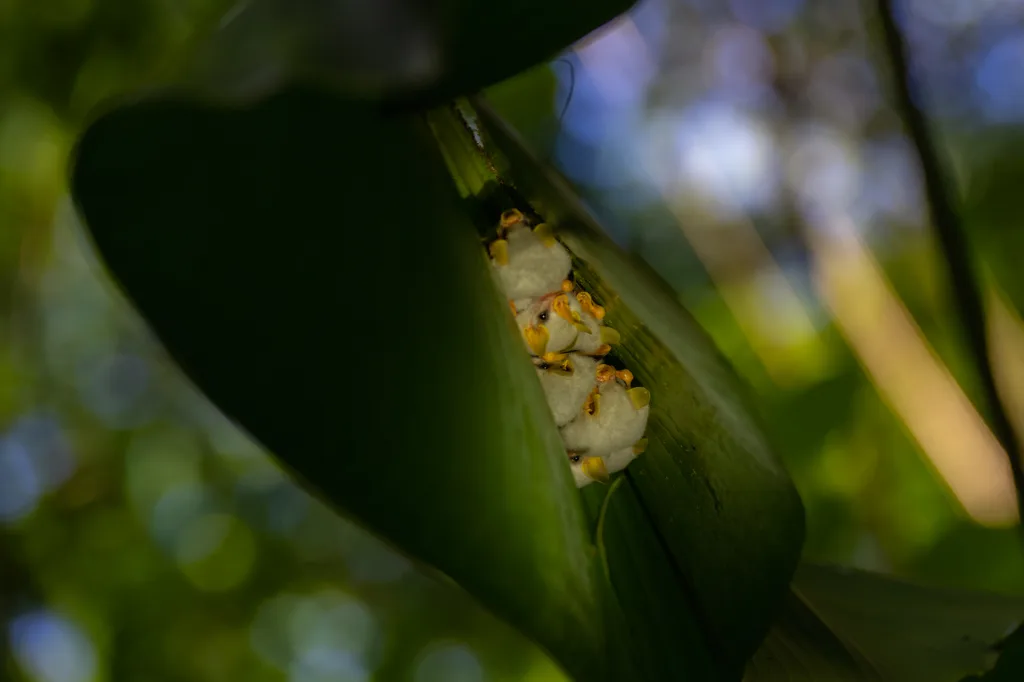
We head back to the van. The boots are slick with mud and I wonder what’s the plan for that. Cope brings us to a pebbly stream and asks us to stand in the running water for a few minutes. Then he calls us one by one, making us put one foot up at a time on a rock, and scrubs our boots clean with his bare hands. Once the boots are cleaned to his satisfaction, we get in the van.
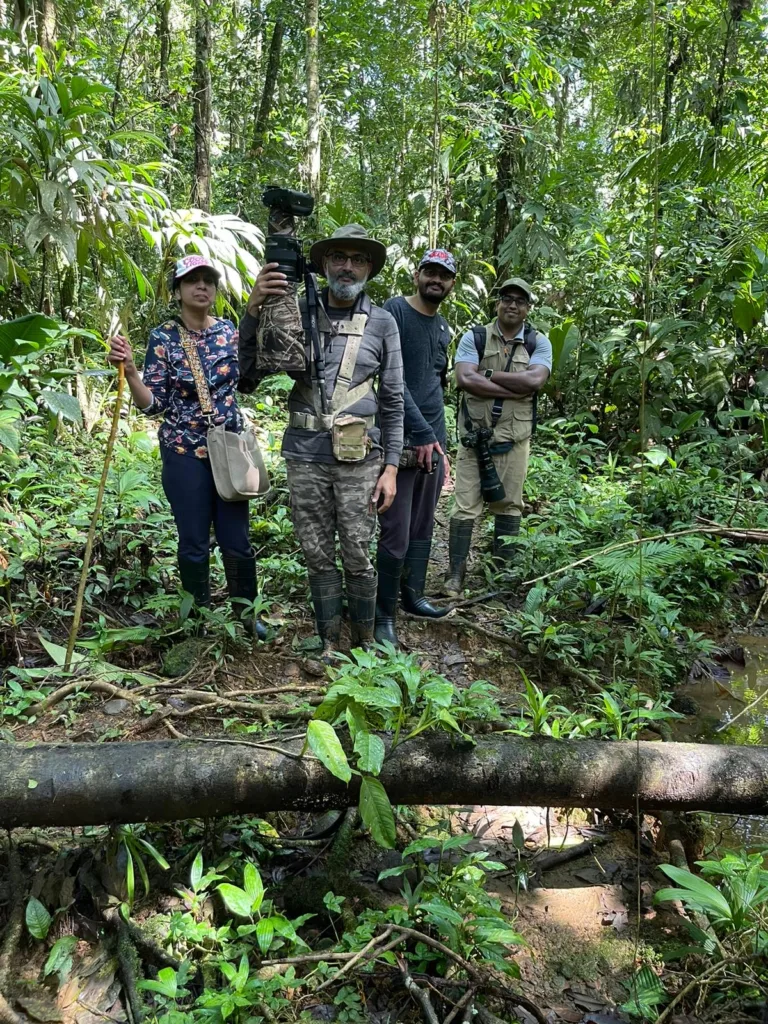

Hummingbirds for the taking
We head out to Cope’s garden once again and have a lunch that Subha had packed so that we don’t lose out on birding time. After having done some 100% genuine nature photography, now it is time for a bit of photography that can be called spurious at best. Cope brings a couple of wildflowers and sprays into them some hummingbird nectar, and the hummingbirds start swarming around them. We indulge.
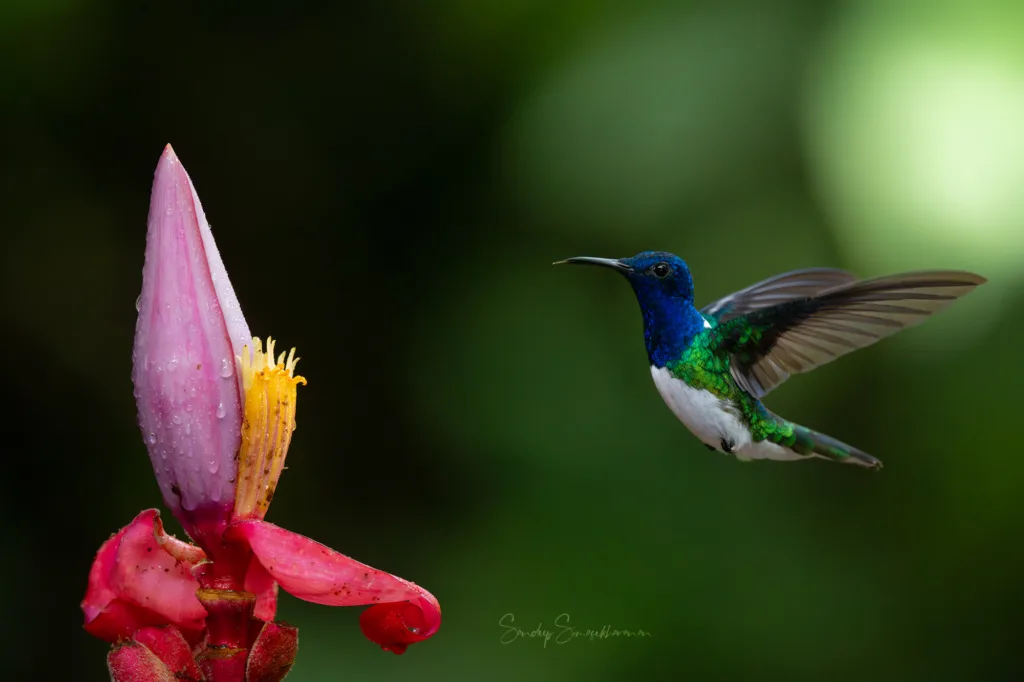

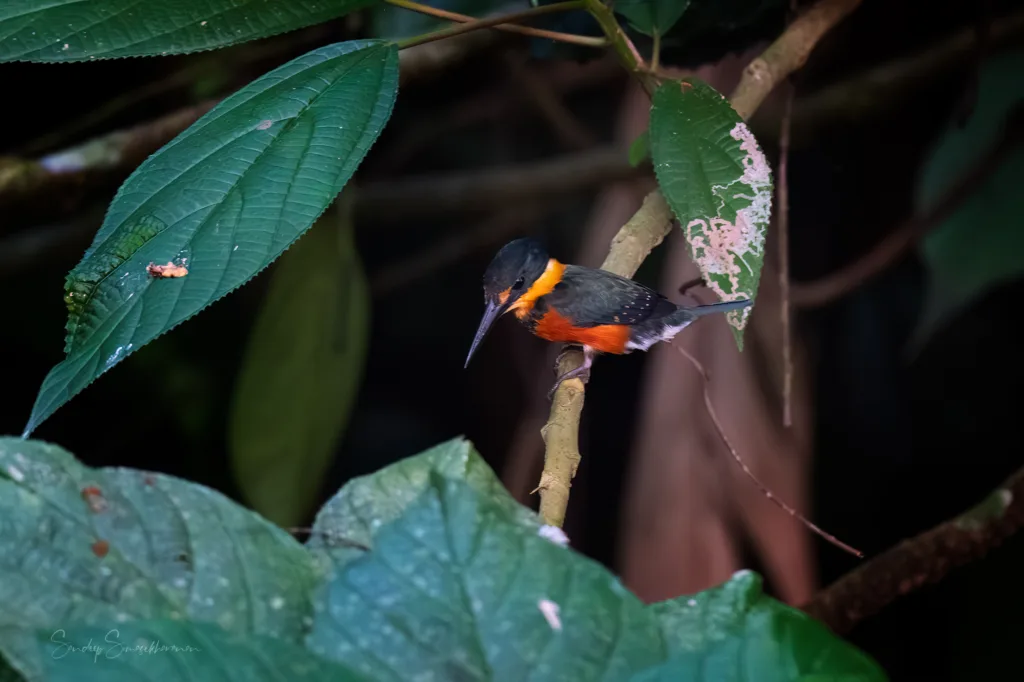
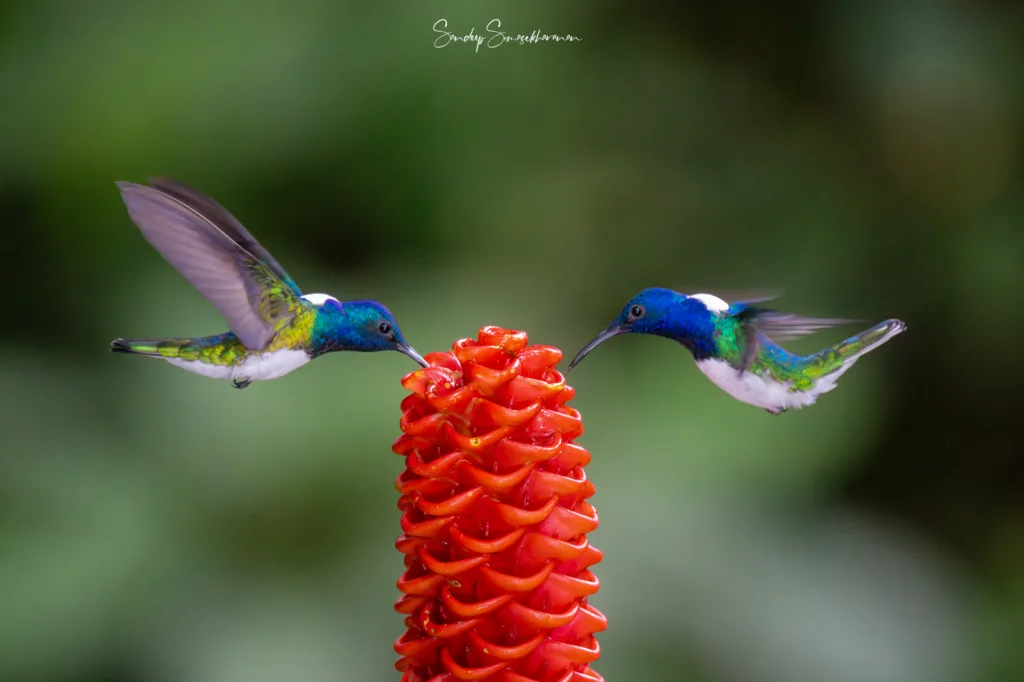
Subha goes into Cope’s house to use the restroom and comes back saying, “His kitchen is immaculately clean! It is as if he doesn’t use it for cooking at all. The bathroom is also spotlessly clean.” This is something we would notice wherever we go in Costa Rica. Cope returns with coffee and some authentic Costa Rican biscuits — they are delicious.
He also shows us some of his incredibly detailed bird paintings – stuff that could find themselves in any field guide. We also get a glimpse of the camera-shy American Pygmy Kingfisher (Chloroceryle aenea), albeit from a distance. A melodious call is heard from the canopy, and a black bird descends on one of the feeders where Cope had dispersed some cooked rice. Melodious Blackbird (Dives dives), says Cope. Not the last instance of lazy nomenclature that we would notice during our trip. A Grey-cowled Wood Rail (Aramides cajaneus) that was wandering in the premises gets used to our presence and ambles close to us, granting some photo opportunities.


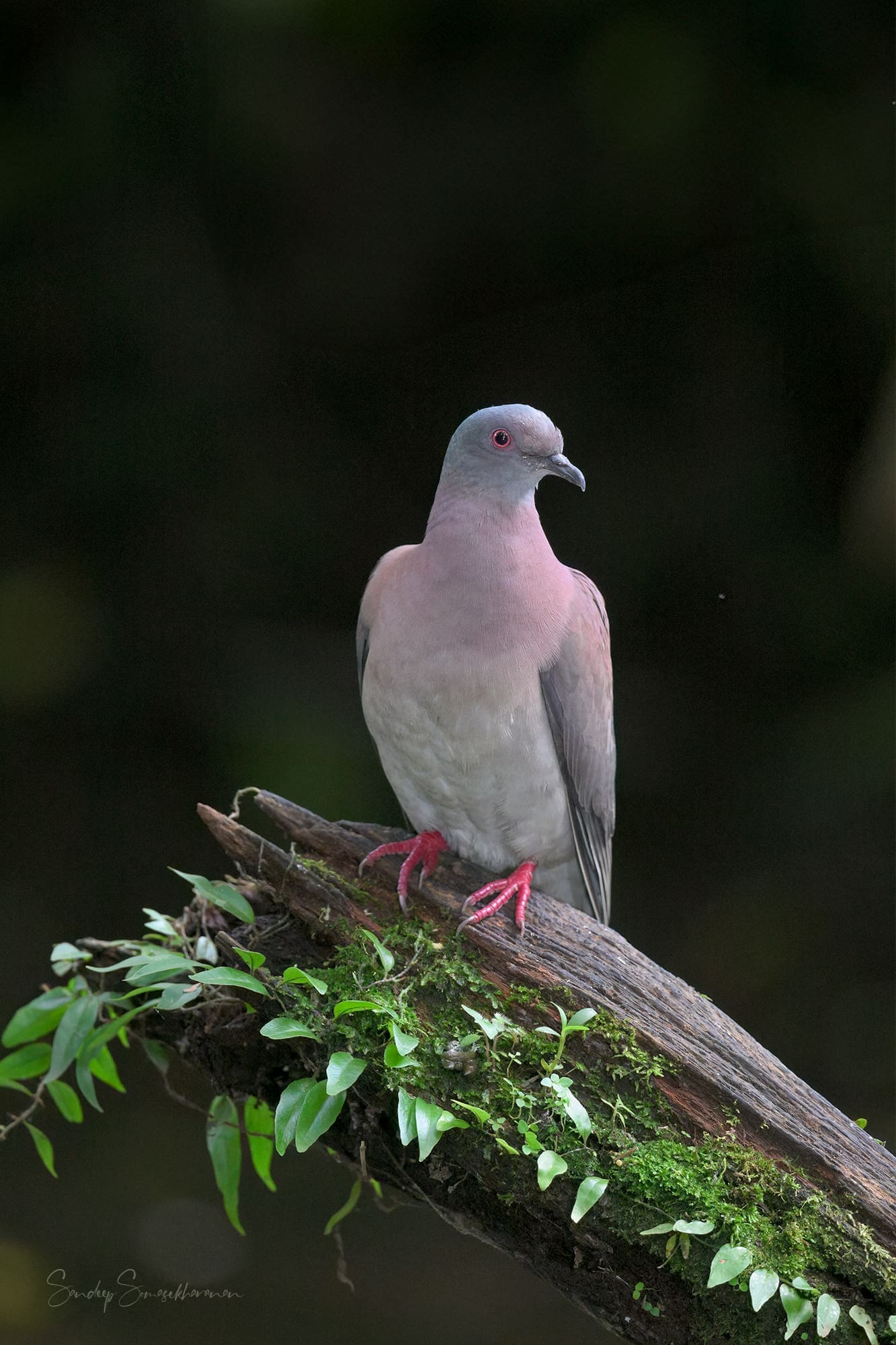
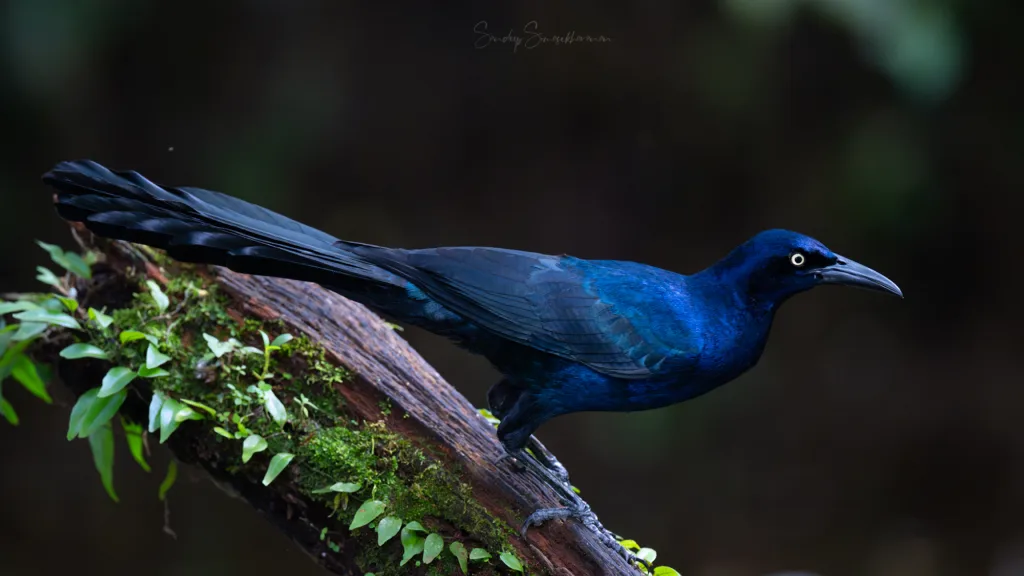
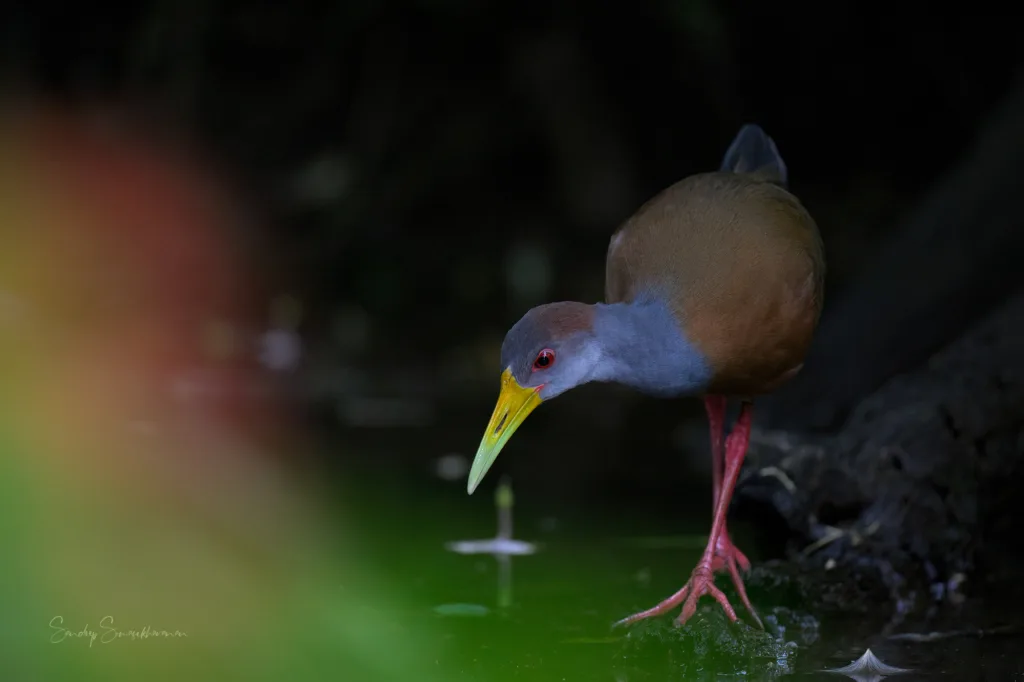
When we feel we have seen everything, there’s a bit of a commotion in the canopy again. The smaller birds move away and a large bird with a diagnostically oversized beak descends on the feeder.
“Toucan, toucan!” Pranav whispers. Indeed, we are blessed by a Yellow-throated Toucan (Ramphastos ambiguus), which unleashes a merciless evisceration of the plantains with its heavy-duty mandibles. A Collared Aracari (Pteroglossus torquatus) appears as well, and enjoys some of the spoils for a brief period.
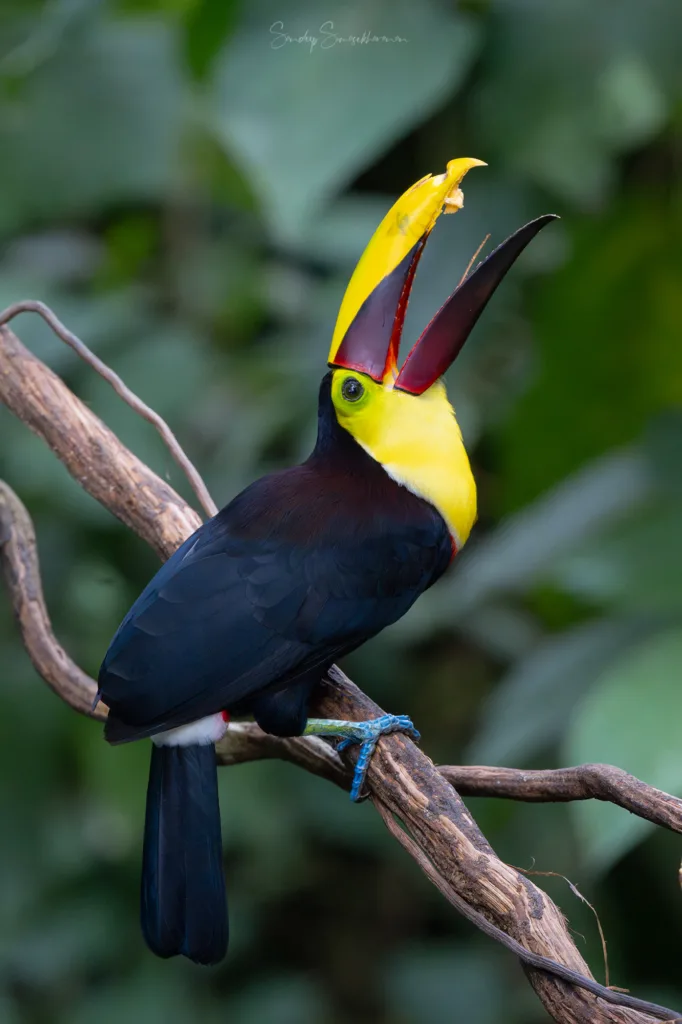
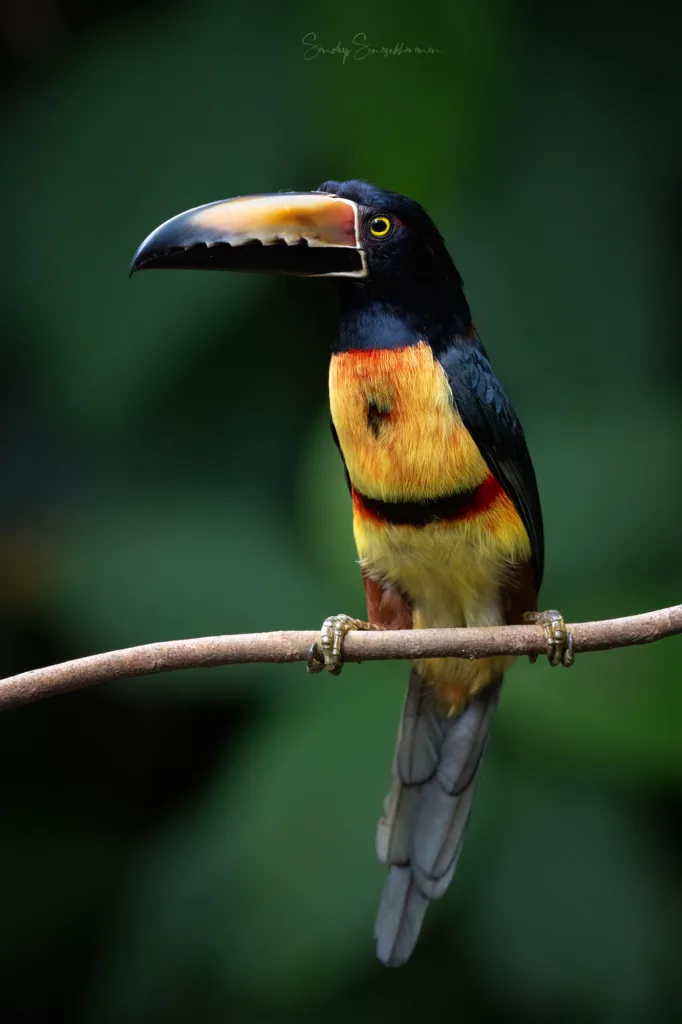
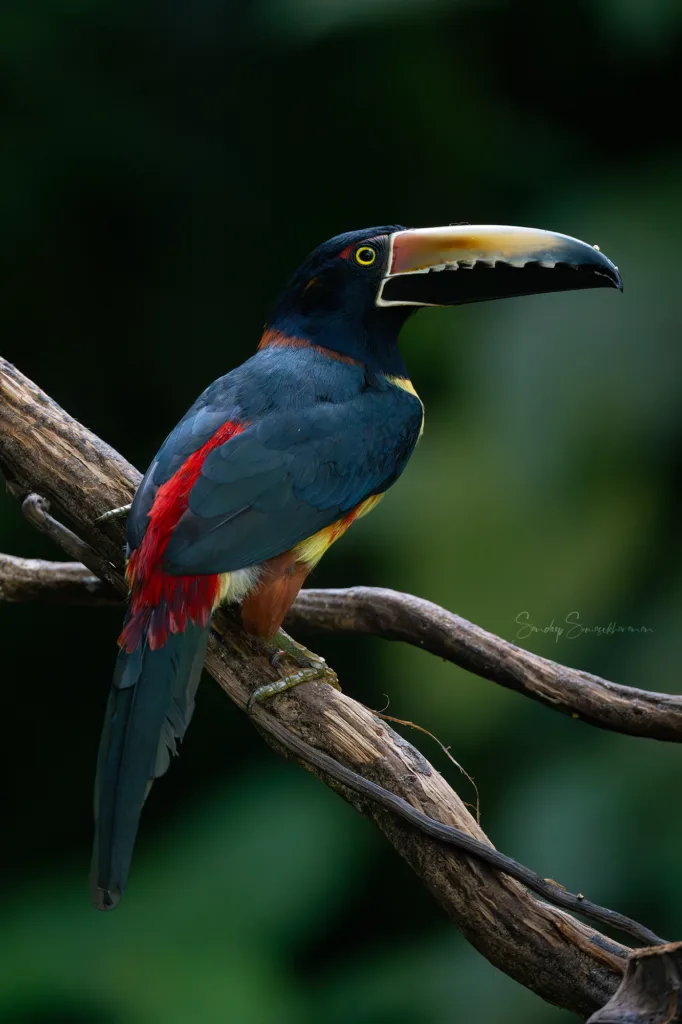
Return from Guapiles
Finally, around 4 pm, we thank Cope from the bottom of our hearts and troop out through the tunnel of trees that stand sentinel to his house. Back at La Quinta, we head towards the feeder and are rewarded with a new sighting — a Golden-hooded Tanager (Stilpnia larvata). There’s also a pair of Green Honeycreepers (Chlorophanes spiza) hopping about the platform. The indolence in calling an iridescent aquamarine bird “green” seems unforgivable, unless whoever named it had only seen the female.
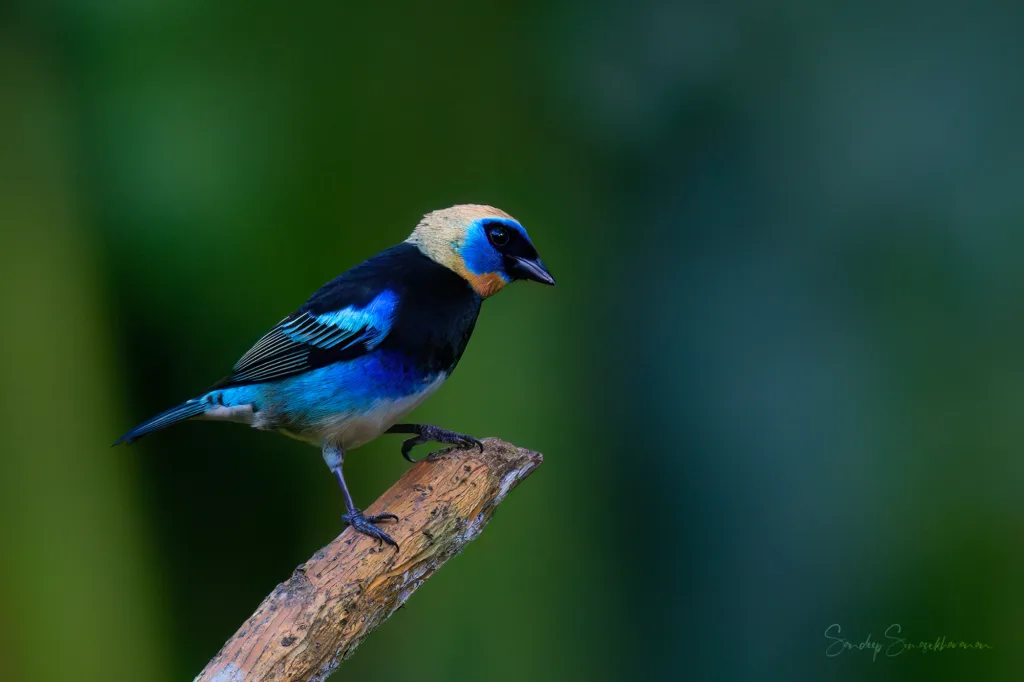
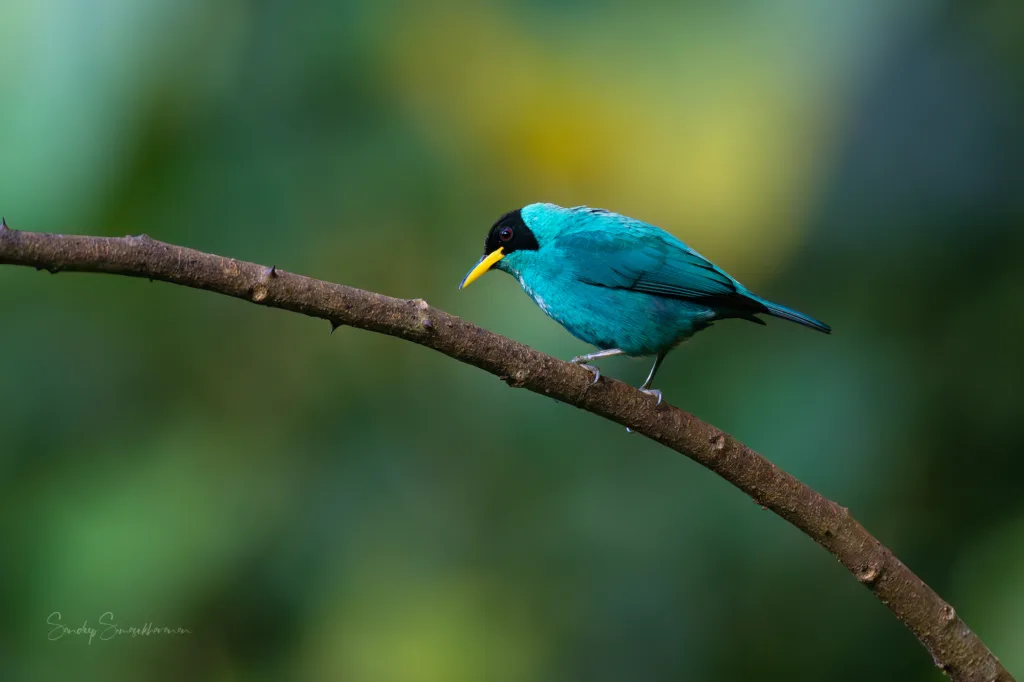
As the light fades, we return to our rooms, freshen up, and head to the cafeteria. The elaborate fruit arrangements remind us that it is Christmas Eve. Dinner is sumptuous again; but there is a special dish tonight. Tamales — corn dough, potatoes, rice, and some meat rolled in a banana leaf and steamed to a melt-in-your-mouth consistency. We eat till we can barely get up.
After dinner, we head out to the tree frog observation area within the resort. It is a patch of rainforest with numerous puddles. The resort owners have tried to keep endemic plants in the area, and we soon spot a bullfrog and another tiny frog, which we later identify as a Common Tink Frog (Diasporus diastema). The prize frog evades us still, till someone points it out. About 7 feet from the ground, atop a tree, sits a frog with protruding red eyes that could have inspired the design of Sauron in Lord Of The Rings – a Red-eyed Tree Frog (Agalychnis callidryas). It sports green on its upperparts, while the flanks are blue with yellow stripes. This feels like a second course of dessert and, having shot our fill, we call it a day.

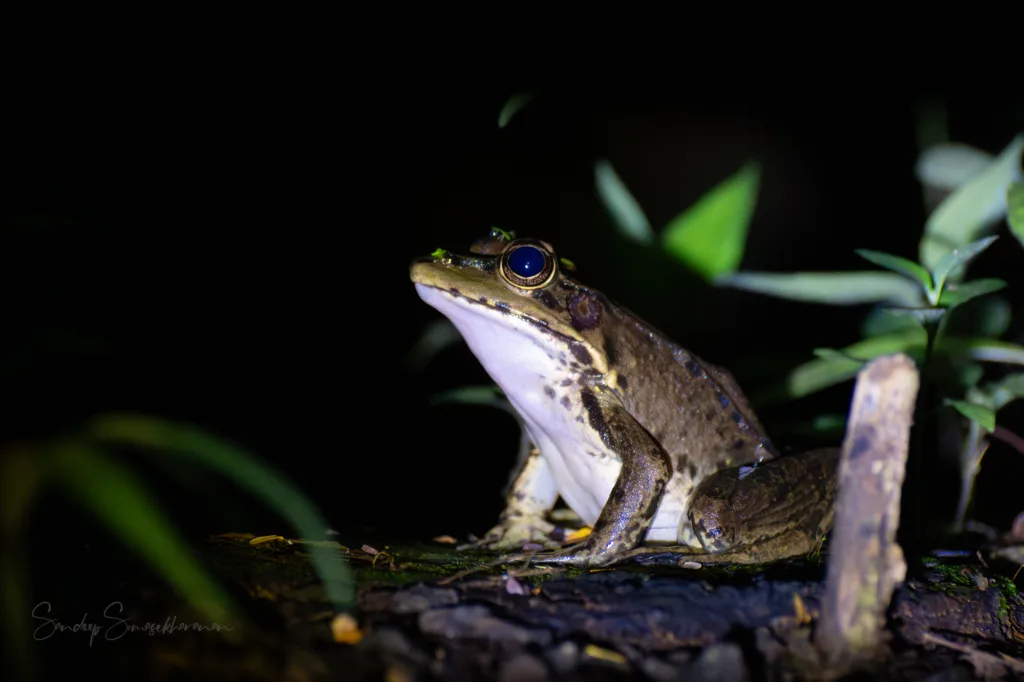
Christmas has indeed come a day early.
Is crazy!
- Costa Rica Diaries – Parting Gifts - May 5, 2024
- Costa Rica Day 6 – Resplendent Quetzal: Part Bird, Part God and Full-Time Economy Driver - April 17, 2024
- Costa Rica Day 5 – Toucan Trees and Wild Dreams Coming True - March 22, 2024

